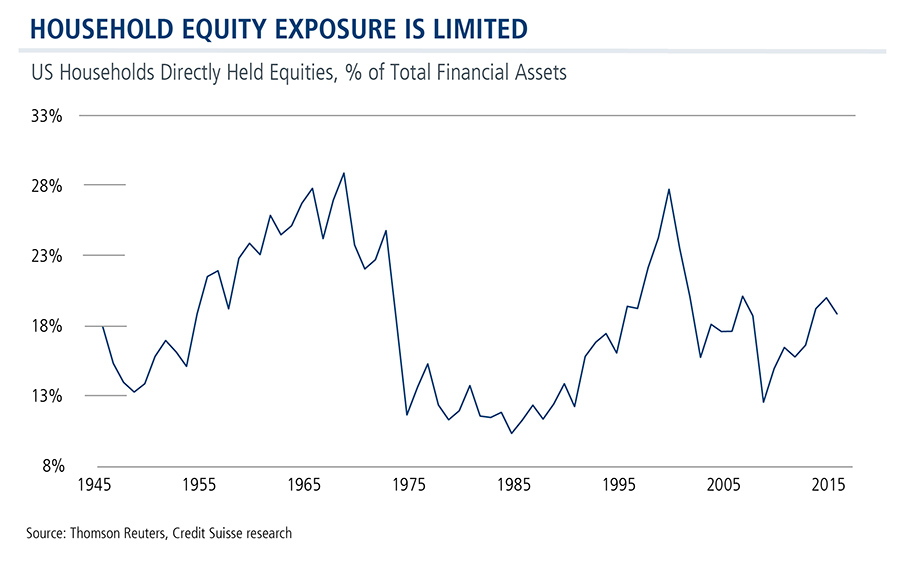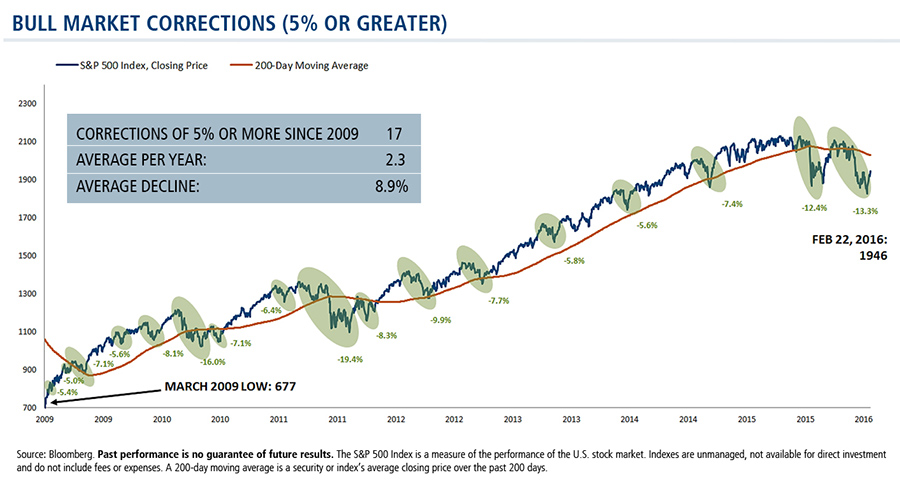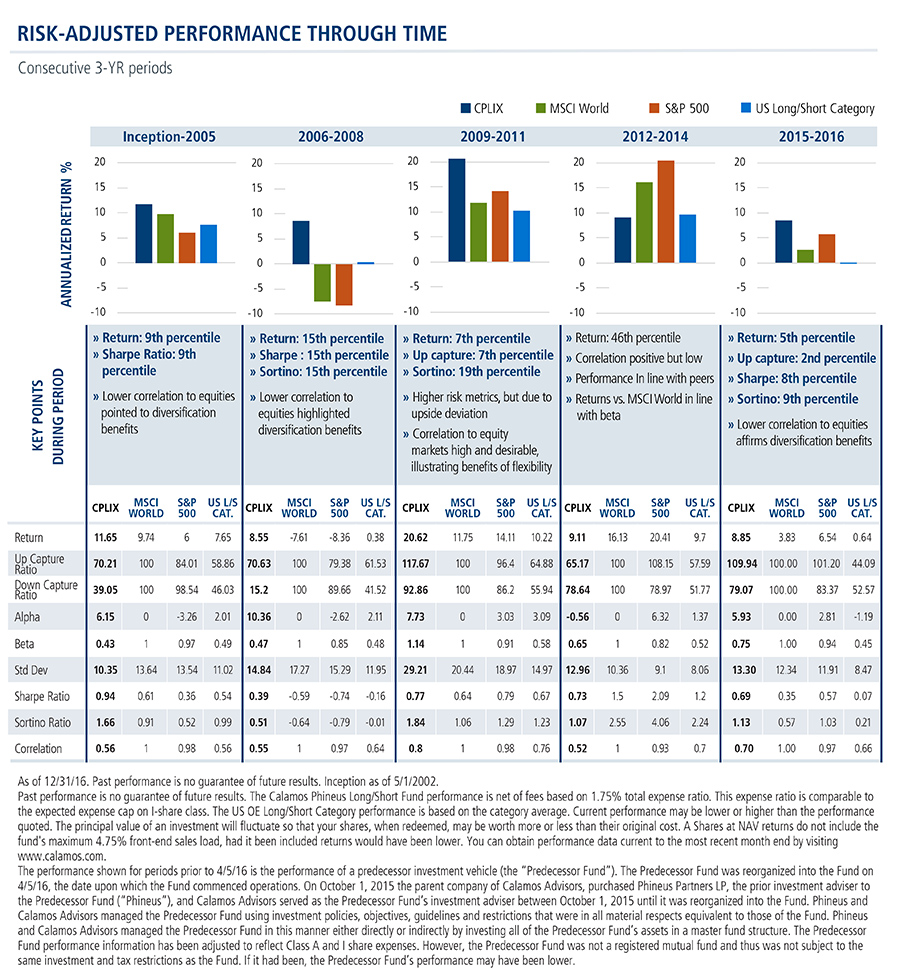Today’s Wall Street Journal describes the dilemma of the individual investor anticipating a return to, or making a greater commitment to, the stock market.
On the one hand, the 2017 rally has attracted record net inflows into global equity funds, according to fund tracker EPFR Global quoted in the piece. But there’s the nagging question: Are people who have been underinvested just now catching up at the wrong time, given current valuations?
We have two points we’ll add to the conversation that financial advisors are no doubt having with their clients.
Hedge Against Inflation
The return to equities is warranted given the economic growth expected, says Michael Grant, Senior Co-Portfolio Manager of Calamos Phineus Long/Short Fund.
Here’s a chart that’s part of every presentation Grant delivers, suggesting that equities are a "structurally under-owned inflation hedge."
“The vast bulk of the world is still structurally overweight with deflation hedges. Investors are not prepared for more reflation-like outcomes in coming years," Grant believes.

Yes, The Market Likely Will Drop at Some Point
Second, advisors and investors are correct to be anticipating a market decline of some sort. Much has been made of the eight-year bull market that started in 2009. But there were 17 corrections of 5% or more in the 2009 to 2017 period.
Bull market corrections happen—and haven’t kept the market from climbing long term.

(click image to enlarge)
The Potential Benefit of an Equity Alternative
It’s in these times when an equity alternative may help. While investors are drawn to the return potential of equities, they routinely lose their nerve when markets turn upside down. The long/short structure of Calamos Phineus Long/Short Fund, with its mandate to hedge and lessen downside, seeks to minimize the worst case outcomes. Its long-term performance record and consistency may help clients remain committed to a full market cycle.

Financial advisors, for more information on Calamos Phineus Long/Short Fund, talk to your Calamos Investment Consultant at 888-571-2567 or
caminfo@calamos.com
Before investing, carefully consider the fund’s investment objectives, risks, charges and expenses. Please see the prospectus and summary prospectus containing this and other information which can be obtained by calling 1-866-363-9219. Read it carefully before investing.
Opinions, estimates, forecasts, and statements of financial market trends that are based on current market conditions constitute our judgment and are subject to change without notice. The views and strategies described may not be suitable for all investors. References to specific securities, asset classes and financial markets are for illustrative purposes only and are not intended to be, and should not be interpreted as, recommendations.

Performance data quoted represents past performance, which is no guarantee of future results. Current performance may be lower or higher than the performance quoted. The principal value and return of an investment will fluctuate so that your shares, when redeemed, may be worth more or less than their original cost. Performance reflected at NAV does not include the Fund’s maximum front-end sales load of 4.75%. Had it been included; the Fund’s return would have been lower. For the most recent month-end fund performance information visit www.calamos.com.
The performance shown for periods prior to 4/5/16 is the performance of a predecessor investment vehicle (the “Predecessor Fund”). The Predecessor Fund was reorganized into the Fund on 4/5/16, the date upon which the Fund commenced operations. On 10/1/15 the parent company of Calamos Advisors, purchased Phineus Partners LP, the prior investment adviser to the Predecessor Fund (“Phineus”), and Calamos Advisors served as the Predecessor Fund’s investment adviser between 10/1/15 until it was reorganized into the Fund. Phineus and Calamos Advisors managed the Predecessor Fund using investment policies, objectives, guidelines and restrictions that were in all material respects equivalent to those of the Fund. Phineus and Calamos Advisors managed the Predecessor Fund in this manner either directly or indirectly by investing all of the Predecessor Fund’s assets in a master fund structure. The Predecessor Fund performance information has been adjusted to reflect Class A and I shares expenses. However, the Predecessor Fund was not a registered mutual fund and thus was not subject to the same investment and tax restrictions as the Fund. If it had been, the Predecessor Fund’s performance may have been lower.
Alternative investments may not be suitable for all investors, and the risks of alternative investments vary based on the underlying strategies used. Many alternative investments are highly illiquid, meaning that you may not be able to sell your investment when you wish to.
Unmanaged index returns assume reinvestment of any and all distributions and do not reflect any fees, expenses, or sales charges. Investors cannot invest directly in an index.
The S&P 500 Index is a market weighted index and is widely regarded as the standard for measuring U.S. stock market performance.
MSCI World Index is a market capitalization weighted index composed of companies representative of the market structure of 21 developed market countries in North America, Europe, and the Asia/Pacific region. Unmanaged index returns assume reinvestment of any and all distributions and do not reflect fees, expenses or sales charges. Investors cannot invest directly in an index. The MSCI World Index consists of the following 23 developed market country indexes: Australia, Austria, Belgium, Canada, Denmark, Finland, France, Germany, Hong Kong, Ireland, Israel, Italy, Japan, Netherlands, New Zealand, Norway, Portugal, Singapore, Spain, Sweden, Switzerland, the United Kingdom, and the United States.
Morningstar U.S. Funds Long/Short Category: Long-short portfolios hold sizable stakes in both long and short positions in equities and related derivatives. Some funds that fall into this category will shift their exposure to long and short positions depending on their macro outlook or the opportunities they uncover through bottom-up research. Some funds may simply hedge long stock positions through exchange-traded funds or derivatives. At least 75% of the assets are in equity securities or derivatives.
The principal risks of investing in the Phineus Long/Short Fund include: equity securities risk consisting of market prices declining in general, short sale risk consisting of potential for unlimited losses, foreign securities risk, currency risk, geographic concentration risk, other investment companies (including ETFs) risk, derivatives risk, options risk, and leverage risk.
The principal risks of investing in the Market Neutral Income Fund include: equity securities risk consisting of market prices declining in general, convertible securities risk consisting of the potential for a decline in value during periods of rising interest rates and the risk of the borrower to miss payments, synthetic convertible instruments risk, convertible hedging risk, covered call writing risk, options risk, short sale risk, interest rate risk, credit risk, high yield risk, liquidity risk, portfolio selection risk, and portfolio turnover risk.
Alpha: A historical measure of risk-adjusted performance. Alpha measures how much of a portfolio’s performance is attributable to investment-specific factors versus broad market trends. A positive alpha suggests that the performance of a portfolio was higher than expected given the level of risk in the portfolio. A negative alpha suggests that the performance was less than expected given the risk.
Beta: A common measure of historic volatility, beta measures how much of an investment’s performance is attributable to market-wide factors (such as a rising stock market). An investment that goes up or down as much as a broad market measure has a beta of 1. An investment that captures only half of the market’s movements would have a beta of 0.5.
Sharpe ratio: A measure of risk-adjusted performance, where higher values are indicative of better investment decisions rather than the result of taking on a higher level of risk. Sharpe ratio is calculated by the difference between a portfolio’s return and a risk-free rate, often that of the 10-year Treasury bond, and dividing the result by the portfolio’s standard deviation.
Standard Deviation: Measures the overall risk of a fund.
Correlation: a statistical measure that shows how two securities move in relation to each other. A correlation of 1 implies that if one security moves up or down, the other security will move in lockstep, in the same direction. Alternatively, a correlation of 1 means that if one security moves in either direction, the other security will do the exact opposite.
Sortino ratio: The excess return over the risk-free rate divided by the downside semi-variance, and so it measures the return to "bad" volatility. (Volatility caused by negative returns is considered bad or undesirable by an investor, while volatility caused by positive returns is good or acceptable.)
Upside/downside capture ratios: Show whether a given fund has outperformed--gained more or lost less than--a broad market benchmark during periods of market strength and weakness, and if so, by how much. Upside capture is calculated by taking the fund's monthly return during months when the benchmark had a positive return and dividing it by the benchmark return during that same month. Downside capture is calculated by taking the fund's monthly return during the periods of negative benchmark performance and dividing it by the benchmark return.
An investment in the Fund(s) is subject to risks, and you could lose money on your investment in the Fund(s). There can be no assurance that the Fund(s) will achieve its investment objective. Your investment in the Fund(s) is not a deposit in a bank and is not insured or guaranteed by the Federal Deposit Insurance Corporation (FDIC) or any other government agency. The risks associated with an investment in the Fund(s) can increase during times of significant market volatility. The Fund(s) also has specific principal risks, which are described below. More detailed information regarding these risks can be found in the Fund’s prospectus.
NOT FDIC INSURED | MAY LOSE VALUE | NO BANK GUARANTEE

